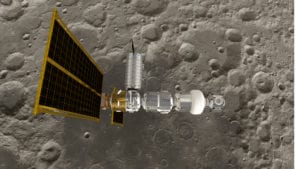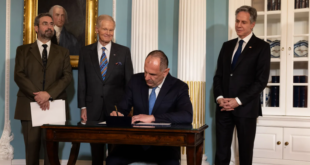by Kiran Mohan Vazhapully

Last month, based on a Reuters report, Chris Borgen wrote in Opinio Juris about the White House chalking out details of a United States (US) sponsored international framework dubbed “Artemis Accords”, to facilitate commercial mining on the Moon. They are conceived as inter-agency bilateral agreements similar to the International Space Station Intergovernmental Agreement (ISS-IGA). The moniker comes from NASA’s mission to land “the first woman and the next man” on the Moon by 2024. More recently, NASA has released its constitutive principles (Artemis Principles).
The latest move follows President Trump’s Executive Order (EO) promulgated in April 2020 which recapitulates the US policy on commercial recovery and use of space resources. The Order clearly stated that the US does not view outer space as “a global commons”—a term used to signify extraterritorial spaces with common-pool resources. The Accord is consistent with the assertion in the Executive Order that the US administration would seek international support for the exploitation and use of space resources and to this end “shall seek to negotiate joint statements and bilateral and multilateral arrangements.” Together, they are seen as part of the concentrated efforts by the US to chart an alternate course of international law-making aimed at bypassing the UN-centric multilateral deliberations on the issue. This post is a brief critique of the Accords and the EO.
The abovementioned Reuters report also hinted at the plans of US diplomats to open talks with its space partners— Japan and Canada— and “like-minded” countries in the European Union such as Luxembourg, as well as the UAE. From what it appears, other space powers with similar ambitions such as Russia, China and India are kept out of these negotiations for now. Russia, not surprisingly, called for a thorough analysis of the proposed blueprint to verify their compliance with international law. Their reaction to the Executive Order was more blunt— comparing the policy to colonialism.
Public-Private Interests in Space Mining
Both Russia and China have their own plans for lunar resource prospecting and are exploring the possibility of cooperative arrangements with each other. European Space Agency has announced their project to mine lunar regolith for water and oxygen, by 2025. Similarly, India has been investing heavily on its Chandrayaan Moon mission. Japan’s Hayabusa spacecrafts have already collected samples from asteroids to bring back to the Earth.
Contrastingly, non-space faring States like Luxembourg and the UAE follow a different policy model. Luxembourg aspires to develop the Duchy into the European hub of commercial space activities focused on space mining through its unique “Space-Resources.lu” initiative, a twin-pronged, long term strategy to be a space mining investor and enabler. Following the US example, they notified the Law of July 20th, 2017, on the Exploration and Use of Space Resources, which provides a detailed procedure for licensing. The primary aim of this law is to create a legal infrastructure for commercial space mining by offering certainty as to the ownership of commercially mined space resources, in particular on asteroids, thereby providing a definitive incentive for prospective mining companies to establish their operations in the country. The Duchy has also dabbled in investing in US-based asteroid mining start-ups. More recently, the UAE enacted the Federal Law No. (12) of 2019 on the Regulation of the Space Sector. The legislation inter alia provides for the facilitation of private space mining in its jurisdiction.
Private players were the prime movers of what has been now frequently referred to as the “next gold rush”. Despite recent setbacks, this niche start-up community remain bullish about its long term prospects. A 2017 report of Goldman Sachs advises investors to think beyond well-established industries within space and pay attention to nascent ventures like space mining. An optimistic market projection puts the size of the asteroid mining market at $3,868.9 million by as early as 2025. It was these enterprises that lobbied for the 2015 US law.
Outer Space as Global Commons
As pointed out in this 2018 EJIL: Talk! post, the 2015 legislation claim to be compliant with the 1967 Outer Space Treaty (OST) to which the US is a party. The Executive Order and the Artemis Principles follow a similar strategy. The EO states that the US policy on encouraging international support for commercial space mining shall be “consistent with applicable law.” The Artemis Principles are more explicit and elaborate in endorsing some of the significant obligations in the OST. Some of the Artemis Principles (“peaceful purposes”, “space resources” and “deconfliction of activities”) are presented as providing facilitative mechanisms for effectuating a few broadly-set rules of the OST. However, some stipulations of these documents squarely run against lex lata on the exploration and the use of outer space and the threw open a few questions on their real intent.
To start with, the US position on the legal status of outer space, stated in the EO, is problematic. As highlighted in the open letter, addressed to the Foreign Affairs Minister of Canada, and Vancouver Recommendations on Space Mining, this position run against the long-standing understanding in the international community that the outer space is a “global commons” and that the exploration and use of its resources should be governed by an international agreement. The term “global commons” indeed lack legal articulation. Nonetheless, a combined reading of preambular paragraphs and Articles I (exploration and use) and II (non-appropriation) of the OST makes it evident that the state parties intended to hold outer space as one.
Further, the EO rejects the applicability of the 1979 Moon Agreement (MA) to any prospective lunar governance regime. In addition, it states that “the [US] Secretary of State shall object to any attempt by any other state or international organization to treat the [MA] as reflecting or otherwise expressing customary international law.” Though they evoke similar imageries in international law and diplomacy, “global commons”— resource domains beyond national jurisdictions— is distinct from the concept of “Common Heritage of Mankind” (CHM) as incorporated in the Moon Agreement. The latter, which came into prominence through “the emergence of North-South cleavage” in the law of the sea, essentially is an approach to manage the former. Not being a party to the MA, it is within the right of the US to reject the MA as the basis for the management of lunar resources. But questions on the validity of this CHM-based management regime should be decoupled from the OST-governed legal status of the outer space, including the Moon and other celestial bodies.
The Legality of Safety Zones

Seen from this perspective, the proposal for safety zones in the Artemis Principles is directed towards concretizing the US position stated in the EO. Here, safety zones are presented as a solution to a potential conflict— a tool to implement Article IX of the OST and reinforce the operational principle of “due regard” in it. Though the definition, scope and extent of the safety zones are matters for future deliberations, any implementation of such “keep-out-zones” (even if not an absolute restriction) will involve some measure of exclusion and alienation, in effect depriving other States of free access to the designated areas. Such denial of access, even if temporary or limited in nature, will directly affect the freedom of exploration and use of a third-state, guaranteed in Article I, paragraph 2 of the OST. This freedom is widely considered as customary law. It follows that universal consensus is a prerequisite to its implementation and bilateralism focussing on “like-minded” space-faring States is conceivably is not the way to work out comprehensive concurrence on this matter.
This provision is complemented by Article II which prohibits “national appropriation of [outer space] by claim of sovereignty, by means of use or occupation, or by any other means.” Notwithstanding the divergent interpretations of this non-appropriation principle among States and academics, the practice of safety zones through bilateral arrangements will involve some form of exercise of sovereignty to the exclusion of other State parties to the OST. It will be perceived as driven by territorial ambitions rather than ideals of transparency and non-interference, and thus raise concerns of appropriation. This again harks back to the necessity of consensus among the community of nations before any such advances. While the Hague International Space Resources Woking Group Building Blocks (Building Blocks) acknowledges the significance of taking into account Article II while declaring safety zones (BB 11.3), it too offers little on how it does not amount to de facto appropriation.
Questions on Redistribution of Benefits
Overlooked in this American project to eliminate legal uncertainty in commercial lunar mining are questions on benefit sharing. The Artemis Principles, rather unsurprisingly, are silent about operationalizing Article I of the OST which states that “the exploration and use of the outer space, including Moon and other celestial bodies, shall be carried for the benefit and in the interest of all countries…” Despite being in use for decades now, the term “benefit sharing” lacks conceptual clarity and its active vocabulary in international law still has not moved beyond perfunctory commitments such as “capacity-building”, “technical support” and “information sharing”, the UN Law of the Sea Convention (UNCLOS) and the MA being major exceptions. The concept of CHM that forms the basis of benefit-sharing in these two instruments, however, has fallen out of favour. This is evident from the reluctance of major space-faring nations to ratify the MA, and more recently, from the departure of negotiations for an implementing agreement concerning the conservation of Biodiversity in areas Beyond National Jurisdiction (BBNJ) from a fully CHM-based model to a narrower “benefit sharing” mechanism.
The Building Blocks also subscribes to a narrow interpretation of benefit sharing and discourages any monetary obligation on operators or States (BB 13). The Vancouver Recommendations, a product of another recent academic exercise on space mining, in contrast, “encourages the establishment of a mandatory benefits sharing mechanism that includes, but is not limited to, sharing of monetary benefits, for example through an international fund.” [Recommendation VII (20)] The Moon Village Principles too advocates benefit sharing “through all feasible means” but takes a rather conservative stance while citing an example of such “means”. (Principle 2)
A parochial approach to the international framework that excludes a fair and equitable benefit-sharing mechanism is undesirable mainly for two reasons. Firstly, it sidesteps the significance of inter-generational equity in creating an equitable operational paradigm. The importance of preserving resources for future generations holds good on the Moon too as our exploiting potential is constrained by the finiteness of its resources. Secondly, and more importantly, such an approach overlooks the prospects of leveraging this project to comprehensively address global poverty by casting enforceable obligations on all stakeholders. Given the prevailing skepticism towards the UNCLOS model, the international community may look at successful terrestrial redistribution arrangements like the Alaskan Permanent Fund, which provides for tangible benefits to Alaskan residents while efficiently catering to the financial interests of the operators, for inspiration.
Concluding Remarks
Space law making is at the crossroads. What the US administration dispassionately describes as a “bottom-up approach” to the future regulatory framework for space mining may on the surface evince semblance of democracy and transparency. But when a technology leader pushes it by making it mandatory for engaging with it in lunar exploration, such a narrative is quite disingenuous. Broad discussions on space resource activities had already begun in the UN Committee on Peaceful Uses of Outer Space (UNCOPUOS) in 2016. In 2019, Belgium and Greece submitted a working paper proposing the establishment of a working group for the development of an international regime for the utilization and exploitation of space resources. The UAE also made a similar proposal. The deliberations that followed indicated support for a multilateral framework that “[takes] into account the needs and rights of all countries.” The UN process is admittedly slow and will involve protracted discussions on benefit sharing and consensus building with non-space faring States. It is this process that the US administration finds unproductive and time-consuming. Instead, they prefer to reach quick agreements with “like-minded nations” anticipating eventual buy-in from other States to the norms and standards they set.
Now that the US has started proactively pursuing its agenda through the Artemis Accords, the future meetings of UNCOPUOS will witness elaborate deliberations on this matter. While fully agreeing with the ‘adaptive governance’ strategy endorsed by the Hague Working Group to draw the details, the development of a broad multilateral framework with clearly formulated objectives is the need of the hour. Democratic discussions at the UN hopefully will prompt States like the US to reposition their ideology, rethink the fundamental premises of negotiation and in turn, realign strategy while deliberating on a legal framework. Above all, in-principle acceptance of an equitable framework as the basis of any multilateral discussion would go a long way in assuaging the concerns of developing nations and temper fears of neocolonialism in the final frontier.

Kiran Mohan Vazhapully is Legal Officer at the Secretariat of Asian-African Legal Consultative Organization (AALCO), New Delhi. Currently, he is on leave from work specializing in air and space law at McGill University, where he is an Erin J.C. Arsenault Fellow.
https://www.linkedin.com/in/kiran-mohan-vazhapully-531a4410/
https://twitter.com/kiranmohan_v
This article was first published in Opinio Juris.





